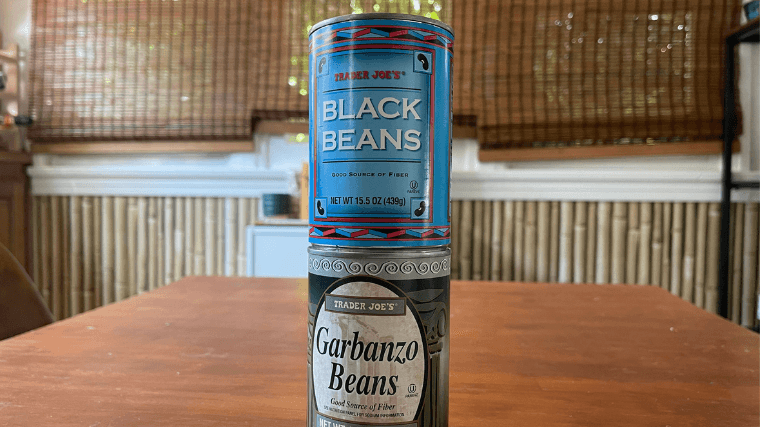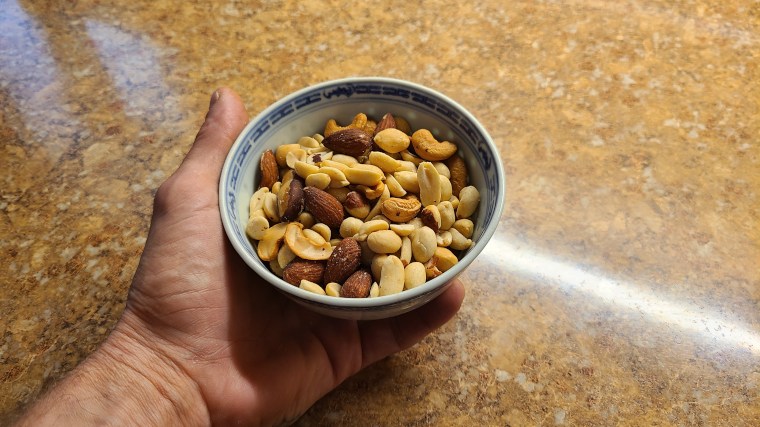If you’re tired of the same old protein shakes or just want to cut back on meat, you’re in luck — plants are here to save the day. From seeds to legumes, the top plant sources of protein deliver the benefits of a protein-rich veggie diet along with fiber, antioxidants, and other nutrients unique to plant-based foods. While supplementing with one of the best protein powders isn’t a bad idea, all diets should prioritize whole foods, which is why we’ve assembled some of the top sources of plant-based protein.
Key Takeaways
- The recommendation for daily protein intake, 0.36 grams per pound of body weight, can be met through a plant-based diet.
- Tempeh is one of the best plant protein sources, containing 34 grams per 1-cup serving. (1)
- Plant-based diets have been shown to reduce risks of cancer, diabetes, heart disease, stroke, and other life-threatening diseases. (2)
- Plant sources of protein are also great sources of iron, magnesium, fiber, and B vitamins.
Editor’s note: The content on BarBend is meant to be informative in nature, but it shouldn’t take the place of advice and/or supervision from a medical professional. The opinions and articles on this site are not intended for use as diagnosis, prevention, and/or treatment of health problems. Speak with your physician or nutritionist if you have any concerns.
The Top 11 Best Plant Sources of Protein (Ranked by Protein Content)
If you’re trying to put on muscle or maintain your gains during weight loss, getting enough protein can be just as challenging as making sure you’re sticking to your fitness routine. This is especially true for those following a high-protein vegan or plant-based diet, where vegan and vegetarian protein sources often have lower protein density compared to animal proteins.
“It was once believed that plant-based diets are inadequate for muscle growth. In fact, recent research has shown that vegan diets can produce equal results when compared to an omnivorous diet; however, it’s important to focus on the amount of protein consumed,” says BarBend expert contributor and registered dietitian Austin Bou.
Since many plant-based proteins lack some essential amino acids, you’ll want to consume a variety of different foods. To help you write up your next grocery list, we’ve highlighted some of the best plant-based protein sources, ranked by protein content per serving. And before you dive in, try out our protein intake calculator to get an estimate of how much protein you need each day to support your goals.
1. Tempeh
Tempeh has 34 grams of protein per cup. (1) It’s a plant-based food that originated in Indonesia and is made from fermented soybeans, which give it its firm texture and slightly nutty flavor. Tempeh is a versatile meat substitute that can be used in soups, sauces, chilis, or even sliced into thin strips and pan-fried to be used in sandwiches or salads.
According to the United States Department of Agriculture (a source we’ll use throughout this article) a half-cup serving delivers 195 calories, 11 grams of fat, and 7 grams of carbohydrates, as well as noteworthy amounts of calcium, magnesium, iron, and potassium. (3)
2. Tofu
Tofu is perhaps the greatest staple in my plant-based diet, thanks to its versatility and usability in a vegan sports nutrition plan. Its subtle flavor easily absorbs marinades, and you can use tofu to add a hit of protein to almost any meal, from pad thai or a stir fry to lettuce wraps and kebabs.

Sauté it, bake it, grill it, scramble it, or blend it into smoothies or desserts — just add one scoop of protein powder and some tofu into a blender and you’ve got yourself a nutritious, high-protein pudding. Each cup of tofu provides 24 grams of protein, plus essential minerals like calcium and iron. It also features a rich amino acid profile. (1)
3. Quinoa
Quinoa is a nutrient-dense, gluten-free whole grain — suitable for celiac patients or those with a gluten disorder — that’s a complete protein source thanks to its ability to provide all nine essential amino acids. (4)
Additionally, this plant protein contains essential fatty acids, minerals, dietary fibers, vitamins, and carbohydrates. There are 24 grams of protein per cup, and it’s also rich in B vitamins, magnesium, iron, and fiber. (1)(5) This gluten-free grain is a great addition or base for salads, bowls, soups, stews, or even folded into pizza dough to up your ‘za’s protein count.
4. Plant-Based Protein Powders
“Plant-based protein supplements are good for those that are vegan, vegetarian, or have a dairy sensitivity,” says Austin Bou, registered dietitian and BarBend expert contributor. As such, the best vegan protein powders can help you boost your protein intake. These plant-based proteins utilize protein from sources like peas, hemp, brown rice, and seeds (like pumpkin seeds, watermelon seeds, sunflower seeds, and more). “Soy and pea protein isolates have the highest bioavailability amongst plant proteins,” adds Bou.

Serving sizes can vary from brand to brand, but you’ll typically find between 20 and 25 grams of protein per serving. (1) One thing to keep in mind when perusing plant-based protein powders is that sometimes, depending on their protein source, they may not provide all essential amino acids. Ideally, to present a balanced amino acid profile, look for brands that utilize a variety of protein sources. (6)
5. Lentils
Lentils provide 18 grams of protein per cup and offer a powerful punch of fiber, which can help support digestion, stabilize blood sugar, and promote feelings of fullness (which can help keep hunger at bay between meals). (1)(7)
In addition to protein and fiber, lentils can provide a wide range of vitamins and minerals including folate, iron, and magnesium. (8) In an uncooked half-cup serving, you’ll find about 62 grams of carbohydrates and 360 calories, which can help fuel you for upcoming gym sessions or your weekend basketball game. They’re super easy to incorporate into meals, work well in soups, curries, salads, tacos, and can even be rounded and pounded into homemade veggie burgers.
6. Edamame
Whether you’re looking to pack on muscle mass or are working in a calorie deficit, edamame can be a worthwhile staple to keep you fueled with balanced macros. Edamame are soybeans in their purest form — often still in their fibrous pods which are peeled open to reveal the tasty beans within — that offer protein, fiber, and essential vitamins like folate and vitamin K. You’ll also score minerals like iron and magnesium in each serving, making it a solid option for those on a vegetarian diet looking to boost their nutrient intake. Additionally, it’s a good source of healthy fats, particularly omega-3 fatty acids, which are touted for supporting heart health. Each cup of edamame offers 18 grams of protein and about 12 grams of fat, 8 grams of fiber, and 14 grams of carbohydrates. (9)(1)

These beans are often enjoyed as an appetizer at Japanese restaurants, but can also be added to salads, soups, and stir-fry dishes, or blended into dips like a hummus alternative if chickpeas aren’t your jam. The pods can be steamed or boiled, and a little sprinkle of salt can help add to the flavor. What’s more, they’re honestly really fun to eat out of their pods.
7. Beans and Legumes
Beans are more than just a musical fruit, they’re also versatile foods that provide roughly 15 grams of protein per cup and are rich in complex carbohydrates and fiber, which promote satiety. (1) From black beans and white beans to chickpeas and kidney beans, legumes get high praise for their heart-health benefits due to their fiber content, which may help lower cholesterol levels and support digestive health. In fact, pea protein’s benefits even go so far as providing up to 25% protein by volume. (10)

Beyond their nutrition, beans and legumes take center stage when it comes to mealtime and are used in many types of cuisine. Soups, stews, curries, salads, wraps — even mashed up as a dip or used as a flour substitute in some high-protein dishes (hello, black bean brownies). While we love their versatility and macros, they can cause GI discomfort for some, so it’s best to introduce beans and legumes into one’s diet gradually.
8. Chickpeas
Chickpeas, also known as garbanzo beans, provide 14 grams of protein, 6 grams of fat, 40 grams of carbohydrates, 12 grams of fiber, and 266 calories per cup. (1)(11) These nutrient-dense legumes are also rich in vitamins and minerals like folate, iron, magnesium, and phosphorus, which support bone, heart, and immune function. (12)(13)(14)(15) Plus, they can be enjoyed in a wide variety of ways including mashed-up into a hummus, pan-roasted for a hard and crunchy snack, or added into soups and salads.
9. Nuts and Seeds
If you take a look into the pantries of health-conscious individuals, you’ll be sure to find some cashews, almonds, pistachios, and even hemp seeds.
[Related: Benefits of Hemp Seeds]
These nutrient-dense powerhouses offer healthy fats, plant-based protein, fiber, and essential vitamins and minerals. Unlike saturated fats, which can raise your LDL (bad) cholesterol, nuts and seeds are particularly high in heart-healthy monounsaturated and polyunsaturated fats, which may help lower bad cholesterol levels and support cardiovascular health. (16)

Packed with antioxidants, omega-3s, magnesium, and vitamin E, nuts and seeds can support brain function, improve skin health, and provide lasting energy. (17) From cashews and almonds to chia seeds and flaxseeds, adding a variety of nuts and seeds to your diet can be a simple, tasty way to boost your protein intake and support a balanced diet.
Below is a quick breakdown of the protein content found in some of the most popular options:
- Almonds: 6 grams of protein per ¼-cup (1)
- Cashews: 5 grams of protein per ¼-cup
- Walnuts: 4 grams of protein per ¼-cup
- Pistachios: 10 grams of protein per ¼-cup (18)
- Hemp Seeds: 10 grams of protein per 3 tablespoons
- Chia Seeds: 9 grams of protein per 3 tablespoons
- Flax Seeds: 6 grams of protein per 3 tablespoons
10. Nut Butters
Maybe you grew up having a peanut butter and jelly sandwich packed in your school lunch. Or, maybe you ate peanut butter smeared on celery sticks while watching morning cartoons. Nut butters, which contain roughly 6 grams of protein per 2 tablespoons, can be easily spread on toast, blended into the best protein shakes, or used as a dip with apples and other fruits and veggies. (1)
11. Nutritional Yeast
Nutritional yeast has become my go-to popcorn topper thanks to its impressive 6 grams of protein per 2 tablespoons. (1) In a half-cup serving — which would be way too much for my popcorn needs — you’ll get about 53 grams of protein, 400 calories, 7 grams of fat, 33 grams of carbohydrates, and 27 grams of fiber. (19) What’s more, vitamin B12, which is often missing from vegan and vegetarian diets, is often included in nutritional yeast products. (20)
Nutritional yeast has a sort of nutty, cheesy flavor, which makes it ideal for adding to pasta, salads, nachos, scrambled eggs, pesto, chili, mashed potatoes — just about anything that might benefit from a cheesy flavor and some extra protein. Also, it’s safe for individuals who have dairy allergies or are lactose intolerant.
Final Word
Incorporating a variety of plant-based protein sources into your diet can offer a balanced and nutrient-rich way to meet your protein needs, even if you’re aiming to build muscle or increase your daily intake. Foods like tempeh, tofu, quinoa, lentils, and nuts not only provide a significant amount of protein, but also supply a range of vitamins, minerals, and antioxidants essential for overall health.
No matter your cooking or snacking style, the benefits of protein sourced from plants make it easier than ever to enjoy nutritious, protein-packed meals without relying on animal products. So, whether you’re trying to build muscle or just keep your stomach from growling between meals, remember: plant protein has your back (and biceps and core and quads and glutes). By mixing up your sources, you’ll support your health, keep mealtime feeling fresh and interesting, and fuel your body with the quality protein it needs.
Top Plant Sources of Protein FAQ
What plant is the highest in protein?
Soy products such as tempeh, tofu, and edamame contain some of the highest amounts of protein, providing up to 34 grams of protein per cup. (1)
How do vegans get protein?
Vegans looking for high-protein foods will want to add a variety of soy products, beans, lentils, seitan, quinoa, seeds, nuts, and nutritional yeast. They may also want to consider adding in a vegan protein shake as well to help them reach their daily protein intake goal.
What are five sources of high plant-based protein?
Tempeh, tofu, lentils, edamame, and other beans and legumes are some of the easiest foods to include in a high plant-based protein diet.
How do you get protein as a vegetarian?
In addition to plant-based proteins like tempeh, tofu, beans, legumes, and edamame, vegetarians can utilize eggs and dairy products (if tolerable) to help them reach their protein goals.
References
- Plant-based protein – A simple guide to getting enough – Kendall Reagan Nutrition Center. (2024b, May 17). Kendall Reagan Nutrition Center. https://www.chhs.colostate.edu/krnc/monthly-blog/plant-based-protein-a-simple-guide-to-getting-enough/
- Alexander, H. (2020, November 4). 5 benefits of a plant-based diet. MD Anderson Cancer Center. https://www.mdanderson.org/publications/focused-on-health/5-benefits-of-a-plant-based-diet.h20-1592991.html#:~:text=A%20plant%2Dbased%20diet%20reduces,and%20some%20mental%20health%20illnesses.
- FoodData Central: Tempeh, cooked. (2019, April 1). U.S. Department of Agriculture. https://fdc.nal.usda.gov/food-details/172467/nutrients
- Angeli V, Miguel Silva P, Crispim Massuela D, Khan MW, Hamar A, Khajehei F, Graeff-Hönninger S, Piatti C. Quinoa (Chenopodium quinoa Willd.): An Overview of the Potentials of the “Golden Grain” and Socio-Economic and Environmental Aspects of Its Cultivation and Marketization. Foods. 2020 Feb 19;9(2):216. doi: 10.3390/foods9020216. PMID: 32092899; PMCID: PMC7074363.
- FoodData Central: Quinoa, cooked. (2019, April 1). U.S. Department of Agriculture. https://fdc.nal.usda.gov/food-details/168917/nutrients
- Are Animal Proteins Better for You Than Plant Proteins? (2019, January 16). Cedars-Sinai Blog. https://www.cedars-sinai.org/blog/best-protein.html
- Prof. Dr. Otto Wilhelm Thomé. (1885). LENTIL. In Flora Von Deutschland, Österreich Und Der Schweiz. https://plants.usda.gov/DocumentLibrary/plantguide/pdf/pg_lecu2.pdf
- FoodData Central. (2023, October 26). U.S. Department of Agriculture. https://fdc.nal.usda.gov/food-details/2644283/nutrients
- FoodData Central: Edamame, cooked. (2024, October 31). U.S. Department of Agriculture. https://fdc.nal.usda.gov/food-details/2707436/nutrients
- Shanthakumar P, Klepacka J, Bains A, Chawla P, Dhull SB, Najda A. The Current Situation of Pea Protein and Its Application in the Food Industry. Molecules. 2022 Aug 22;27(16):5354. doi: 10.3390/molecules27165354. PMID: 36014591; PMCID: PMC9412838.
- FoodData Central: Chickpease. (2023, October 23). U.S. Department of Agriculture. https://fdc.nal.usda.gov/food-details/2644288/nutrients
- Ebara S. (2017). Nutritional role of folate. Congenital anomalies, 57(5), 138–141. https://doi.org/10.1111/cga.12233
- Pasricha, S. R., Low, M., Thompson, J., Farrell, A., & De-Regil, L. M. (2014). Iron supplementation benefits physical performance in women of reproductive age: a systematic review and meta-analysis. The Journal of nutrition, 144(6), 906–914. https://doi.org/10.3945/jn.113.189589
- Al Alawi AM, Majoni SW, Falhammar H. Magnesium and Human Health: Perspectives and Research Directions. Int J Endocrinol. 2018 Apr 16;2018:9041694. doi: 10.1155/2018/9041694. PMID: 29849626; PMCID: PMC5926493.
- Office of Dietary Supplements – Phosphorus. (n.d.). https://ods.od.nih.gov/factsheets/Phosphorus-HealthProfessional/
- Saturated Fat. (2024, August 23). American Heart Association. https://www.heart.org/en/healthy-living/healthy-eating/eat-smart/fats/saturated-fats
- Nishi SK, Sala-Vila A, Julvez J, Sabaté J, Ros E. Impact of Nut Consumption on Cognition across the Lifespan. Nutrients. 2023 Feb 16;15(4):1000. doi: 10.3390/nu15041000. PMID: 36839359; PMCID: PMC9965316.
- FoodData Central: Nuts, pistachio nuts, raw. (2023, April 20). U.S. Department of Agriculture. https://fdc.nal.usda.gov/food-details/2515379/nutrients
- FoodData Central: NUTRITIONAL YEAST SUPERFOODS. (2019, December 6). U.S. Department of Agriculture. https://fdc.nal.usda.gov/food-details/719244/nutrients
- White ND. Vitamin B12 and Plant-Predominant Diets. Am J Lifestyle Med. 2022 May 4;16(3):295-297. doi: 10.1177/15598276221076102. PMID: 35706595; PMCID: PMC9189588.